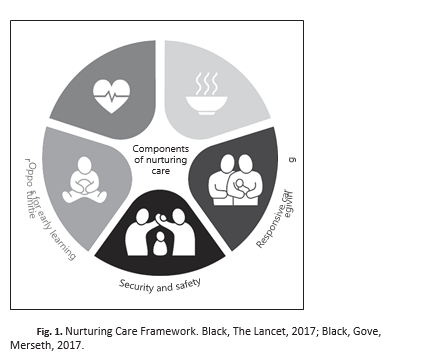Nurturing Care Framework: Implementation Strategies
Childhood development during the first 1,000 days forms the foundation for lifespan health, academic success, productivity, and well-being, and is a cornerstone of the United Nations Sustainable Development Goals (SDGs). At least 7 of the 17 SDGs are particularly relevant to young children: goals to end poverty and hunger, to ensure access to quality health, education and sanitation, to achieve gender equality, and to reduce income inequality. Recent evidence has shown that over 249 million children under age 5 years are not reaching their developmental potential [1] largely due to undernutrition, including both macronutrient and micronutrient deficiencies [2]. Children’s growth and development tracks over time, meaning that children who do not reach their developmental potential early in life are at increased risk for poor health and academic outcomes throughout life. Although effective interventions to promote early development have been implemented throughout the world [3], most have been small scale with limited reach, investment, and sustainability.
Nurturing Care Framework
The Nurturing Care Framework, introduced in the 2017 Lancet series on Early Child Development and adopted by the World Health Assembly in 2018, provides a global framework to promote early childhood development (Figure 1) [4]. Nutrition is a key domain of Nurturing Care, along with health, protection, early learning, and responsive caregiving. These domains are indivisible, meaning that each domain is necessary and no single domain is sufficient.
Implementation of the Nurturing Care Framework is dependent on an enabling environment. Although Nurturing Care is implemented primarily by families through home-based care practices, changing family patterns and increases in maternal employment have resulted in increases in out-of-home care for very young children, often in child care centers. Thus, to ensure that children are exposed to an enabling environment requires support to households and to child care providers to ensure that caregivers have the physical and mental health, resources, and capacity to provide Nurturing Care.

Scaling Up Nurturing Care
As national governments and global leaders adopt the Nurturing Care Framework to ensure that young children reach their developmental potential, implementation guidelines and metrics are needed to help countries monitor and evaluate the effectiveness of implementation strategies and establish sustainable programs. In addition to evaluating changes on SDG indicators, such as the number of children with access to quality early childhood development programs, countries need systematic information on indicators of services, such as reach, coverage, cost, and requirements for training, coaching, and supervision. This information can be generated by a system of accountability that includes valid indicators, quality data, and timely feedback, thereby facilitating continuous quality improvement [4].
Implementation Science
Implementation science includes the methods needed to adopt and integrate evidence-based practices and programs into routine care. Through a continuous cycle of monitoring, evaluation, learning, and adaptation, implementation science provides the tools to adapt programs and practices to increase quality, reach, and sustainability.
This presentation draws on the principles of implementation science, including the methods and strategies needed for families and child care providers to incorporate Nurturing Care into their daily routines. It focuses on child development policies, on program reach to ensure that programs reach families most in need, on monitoring and metrics to learn whether programs are delivering interventions as intended, and on continuous quality improvement to ensure that programs learn and improve: the elements that are necessary for sustainability. The success of the SDGs depends on ensuring that children throughout the world reach their developmental potential, thereby building the capacity for future generations of adults to have the health, intelligence, creativity, and humanitarianism to move the global agenda forward
References
1. Black MM, Walker SP, Fernald LC, et al: Early childhood development coming of age: science through the life course. Lancet 2017;389:77–90.
2. Engle PL, Black MM, Behrman JR, et al; International Child Development Steering Group: Strategies to avoid the loss of developmental potential in more than 200 million children in the developing world. Lancet 2007;369:229–242.
3. Meyers DC, Durlak JA, Wandersman A: The quality implementation framework: a synthesis of critical steps in the implementation process. Am J Community Psychol 2012;50:462–80.
4. World Health Organization, United Nations Children’s Fund, World Bank Group. Nurturing care for early childhood development: a framework for helping children survive and thrive to transform health and human potential. Geneva, World Health Organization, 2018. Licence: CC BY-NC-SA 3.0 IGO. Cataloguing-in-Publication (CIP) data. CIP data are available at http://apps.who.int/iris.
Full article coming soon
